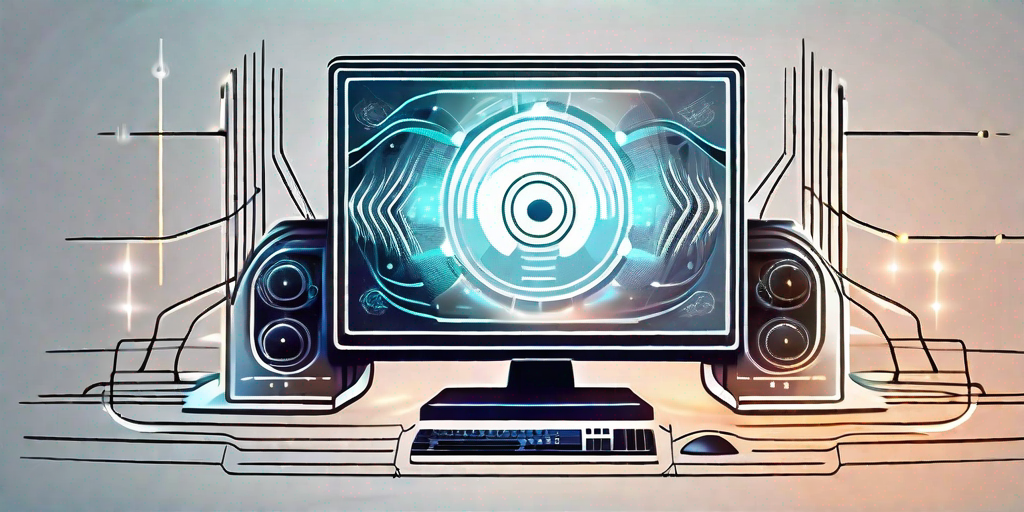Understanding Quantum Computing with an Innovation Speaker's Help

Understanding Quantum Computing with an Innovation Speaker's Help
Quantum computing has emerged as one of the most fascinating and influential fields in recent years. With its promise of unprecedented processing power and the ability to solve complex problems, it's no wonder that businesses and technology enthusiasts alike are eager to understand its basic concepts and implications. In this article, we will explore the fundamental ideas behind quantum computing and how an innovation speaker can help demystify this intricate subject.
Understanding Quantum Computing: The Basic Concepts
Before diving into the role of an innovation speaker in simplifying quantum computing, it's essential to grasp the basic concepts behind this revolutionary technology. Unlike classical computing, which uses bits to represent information as either a 0 or a 1, quantum computing employs quantum bits, or qubits, that can exist in multiple states simultaneously. This ability, known as superposition, enables quantum computers to perform intricate calculations exponentially faster than classical computers.
Superposition is a mind-boggling concept that challenges our traditional understanding of computing. Imagine a qubit as a tiny particle that can exist in a state of both 0 and 1 at the same time. It's like having a coin that is simultaneously both heads and tails. This unique property of qubits allows quantum computers to explore multiple possibilities simultaneously, vastly increasing their computational power.
But how does superposition actually work? Well, it all comes down to the principles of quantum mechanics. In the quantum world, particles can exist in a state of probability, where they have a certain chance of being in one state or another. This probabilistic nature is what gives qubits their superposition ability. By harnessing this property, quantum computers can perform calculations by simultaneously considering all possible outcomes, rather than going through them one by one like classical computers.
Another crucial idea in quantum computing is entanglement. Qubits can become entangled, meaning that the state of one qubit is dependent on the state of another, regardless of the distance between them. This phenomenon allows quantum computers to manipulate multiple qubits simultaneously, unlocking the potential for parallel processing and solving complex problems more efficiently.
Entanglement is like having a pair of quantum particles that are intrinsically linked, no matter how far apart they are. If one particle's state is changed, the other particle's state instantly changes as well, even if they are on opposite sides of the universe. This bizarre behavior is what Albert Einstein famously referred to as "spooky action at a distance." Entanglement is a fundamental property of quantum mechanics and is at the heart of quantum computing's power.
Imagine a scenario where two qubits are entangled. If one qubit is measured and found to be in the state of 0, the other qubit will instantaneously be in the state of 1, regardless of the physical distance between them. This instantaneous correlation between entangled qubits allows quantum computers to perform operations on multiple qubits simultaneously, exponentially increasing their computational capabilities.
With superposition and entanglement as its building blocks, quantum computing holds the promise of revolutionizing various fields, from cryptography and drug discovery to optimization problems and artificial intelligence. The ability to process vast amounts of data and perform complex calculations at an unprecedented speed opens up new possibilities for solving problems that are currently intractable for classical computers.
As we delve deeper into the world of quantum computing, it becomes clear that this technology is not just an incremental improvement over classical computing but a paradigm shift that challenges our fundamental understanding of computation. The concepts of superposition and entanglement are at the core of this revolution, paving the way for a new era of computing that has the potential to transform the world as we know it.
The Role of an Innovation Speaker in Simplifying Quantum Computing
With its inherent complexity, quantum computing can intimidate those not well-versed in the subject. That's where an innovation speaker comes in. These experts are skilled at taking intricate concepts and making them accessible to a broader audience. By utilizing their knowledge and expertise, they can bridge the gap between technical jargon and layman's terms, making quantum computing more approachable.
An innovation speaker can break down the complex ideas behind quantum computing into relatable analogies and real-world examples. They can engage the audience with compelling stories, witty anecdotes, and interactive demonstrations, making the learning experience enjoyable and memorable. Their ability to connect with the audience on a personal level ensures that the information presented is not only understood but retained long after the talk is over.
Imagine sitting in a packed auditorium, eagerly waiting for the innovation speaker to take the stage. As the lights dim, a hush falls over the crowd, and the speaker emerges with an air of confidence. They begin by explaining the fundamental principles of quantum computing, comparing it to a symphony orchestra where each qubit plays a unique instrument, harmonizing together to create a beautiful composition of computations.
The speaker then delves deeper into the concept of superposition, using a clever analogy of a spinning top. They explain how just like a spinning top can exist in multiple states simultaneously, a qubit can exist in a superposition of 0 and 1, opening up a whole new realm of possibilities for computation. The audience is captivated, their eyes lighting up with newfound understanding.
To further illustrate the power of quantum computing, the innovation speaker brings out a prop - a set of interconnected Rubik's cubes. They explain how solving a Rubik's cube is like solving a complex computational problem, and how quantum algorithms can provide exponential speedup in finding the optimal solution. With each twist and turn of the Rubik's cubes, the audience witnesses the potential of quantum computing unfolding before their eyes.
But it's not all about the technical aspects. The innovation speaker knows that engaging the audience emotionally is just as important. They share personal stories of how quantum computing has the potential to revolutionize fields such as drug discovery, climate modeling, and cryptography. The audience is inspired by the possibilities, realizing that quantum computing is not just an abstract concept but a technology that can shape the future.
Throughout the talk, the innovation speaker encourages audience participation, asking thought-provoking questions and inviting volunteers to take part in interactive demonstrations. This hands-on approach ensures that the audience is actively engaged, solidifying their understanding of quantum computing and leaving a lasting impression.
As the talk comes to an end, the innovation speaker leaves the audience with a sense of wonder and curiosity. They emphasize the importance of continued learning and exploration in the field of quantum computing, encouraging everyone to delve deeper into this fascinating subject. The audience leaves the auditorium with a newfound appreciation for the role of innovation speakers in simplifying complex topics and a burning desire to learn more about the exciting world of quantum computing.
Diving Deeper into Quantum Mechanics
While understanding the basic concepts of quantum computing is essential, delving deeper into the underlying principles of quantum mechanics can provide a more comprehensive grasp of this groundbreaking field. Quantum mechanics, the branch of physics that governs the behavior of particles at the quantum level, forms the foundation of quantum computing.
Exploring topics such as wave-particle duality, quantum superposition, and quantum entanglement can shed light on why quantum computing holds such immense potential. Wave-particle duality, for instance, is a fundamental principle in quantum mechanics that states that particles can exhibit both wave-like and particle-like behavior. This concept challenges our classical understanding of physics, where objects are either particles or waves. Understanding wave-particle duality is crucial for comprehending the behavior of quantum systems and how they can be manipulated in quantum computing.
Quantum superposition is another intriguing concept in quantum mechanics. It refers to the ability of quantum systems to exist in multiple states simultaneously. Unlike classical bits, which can only be in a state of 0 or 1, quantum bits, or qubits, can be in a superposition of both 0 and 1 at the same time. This property allows quantum computers to perform parallel computations and potentially solve complex problems much faster than classical computers.
Furthermore, quantum entanglement, often described as "spooky action at a distance" by Albert Einstein, is a phenomenon where two or more particles become correlated in such a way that the state of one particle is instantly linked to the state of another, regardless of the distance between them. This non-local connection is a key resource in quantum computing, enabling the transmission of information and the creation of secure communication channels.
An innovation speaker can guide their audience through these intricate concepts, supplementing the explanations with relevant examples and thought-provoking analogies. For instance, they might use the analogy of a coin spinning in the air to explain wave-particle duality, illustrating how the coin can be both heads and tails until it is observed and collapses into a single state. This visual representation can help the audience grasp the counterintuitive nature of quantum phenomena.
By diving deeper into quantum mechanics, researchers and enthusiasts can gain a deeper appreciation for the potential of quantum computing. The principles of wave-particle duality, quantum superposition, and quantum entanglement provide the building blocks for harnessing the power of quantum systems. As we continue to explore and understand these principles, the possibilities for quantum computing are boundless.
How an Innovation Speaker Can Apply Quantum Computing Concepts in Business
Once the fundamental concepts of quantum computing are understood, the next step is exploring how these principles can be applied in a business context. Quantum computing has the potential to revolutionize various industries, ranging from finance and healthcare to logistics and cybersecurity.
An innovation speaker can highlight specific use cases and demonstrate how quantum computing can optimize processes, enhance decision-making, and unlock new opportunities for businesses. They can provide insights into the potential advantages and challenges of implementing quantum computing solutions, empowering business leaders to make informed decisions about integrating this technology into their operations.
Adapting Your Business Strategy with Quantum Computing Insights
As quantum computing continues to evolve, it's crucial for businesses to stay ahead of the curve and adapt their strategies accordingly. By gaining insights from an innovation speaker, organizations can gain a strategic advantage in a rapidly changing landscape.
An innovation speaker can help businesses identify areas where quantum computing can have the most significant impact and develop a roadmap for integrating this technology into their long-term plans. They can provide guidance on assessing the quantum readiness of an organization, formulating partnerships with quantum experts, and staying informed about the latest developments in the field.
Conclusion
In conclusion, understanding the intricacies of quantum computing is no easy task, but it's a journey worth taking. With the help of an innovation speaker, the complex concepts and applications of quantum computing can be made accessible to a broader audience. By exploring the basic concepts, diving deeper into quantum mechanics, and understanding its potential in various industries, businesses can unlock new opportunities and gain a competitive edge. So, embark on this exciting journey and embrace the possibilities that quantum computing holds. With an innovation speaker's guidance, quantum computing will no longer be a daunting enigma, but a tool that can revolutionize the future of technology and business.
Frequently Asked Questions
1. What are the basic concepts of quantum computing?
Quantum computing utilizes quantum bits, or qubits, which can exist in multiple states simultaneously due to a property called superposition. This allows quantum computers to perform calculations exponentially faster than classical computers. Entanglement is another crucial concept in quantum computing, where the state of one qubit is dependent on the state of another, regardless of the distance between them.
2. How can an innovation speaker simplify the understanding of quantum computing?
An innovation speaker can simplify quantum computing by breaking down complex ideas into relatable analogies and real-world examples. They engage the audience with compelling stories and interactive demonstrations, making the learning experience enjoyable and memorable. Their ability to connect with the audience on a personal level ensures that the information presented is easily understood and retained.
3. How can quantum computing be applied in business?
Quantum computing has the potential to revolutionize various industries, such as finance, healthcare, logistics, and cybersecurity. An innovation speaker can highlight specific use cases and demonstrate how quantum computing can optimize processes, enhance decision-making, and unlock new opportunities for businesses. They can provide insights into the advantages and challenges of implementing quantum computing solutions, empowering business leaders to make informed decisions.
Contact an Innovation Speaker for Your Event
Ignite the spark of innovation at your next event by hiring Dr Mark van Rijmenam, a renowned Innovation Speaker. With his deep understanding of complex concepts like quantum computing, he can transform the cryptic into the comprehensible, making this revolutionary technology accessible to all. Dr van Rijmenam's engaging storytelling and relatable analogies will captivate your audience, ensuring they not only grasp the concepts but also understand how they can be applied in a business context. Don't miss this opportunity to bring the future to your event and inspire your attendees with the boundless possibilities of quantum computing. Simply complete the form below and we will be in touch within 24 hours. Let's embark on this fascinating journey together and unlock the power of quantum computing for your business.
Thanks for your inquiry
We have sent you a copy of your request and we will be in touch within 24 hours on business days.
If you do not receive an email from us by then, please check your spam mailbox and whitelist email addresses from @thedigitalspeaker.com.
In the meantime, feel free to learn more about The Digital Speaker here.
Or read The Digital Speaker's latest articles here.





